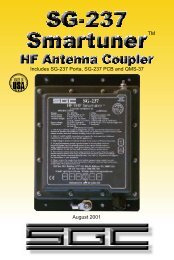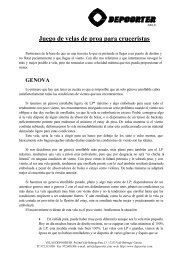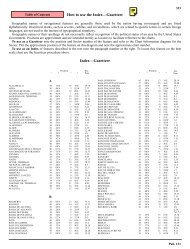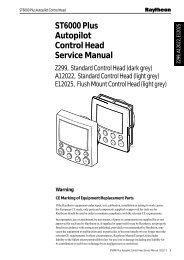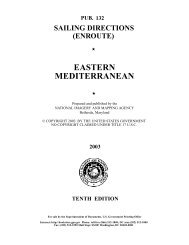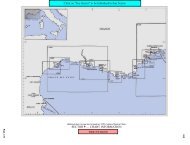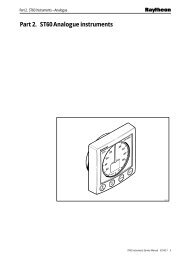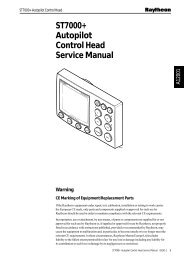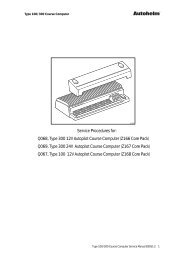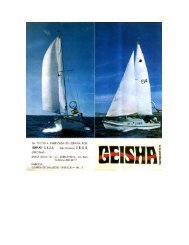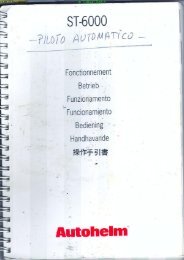Autohelm Inboard Autopilots (ST6000 and ST7000 systems) Service ...
Autohelm Inboard Autopilots (ST6000 and ST7000 systems) Service ...
Autohelm Inboard Autopilots (ST6000 and ST7000 systems) Service ...
- No tags were found...
Create successful ePaper yourself
Turn your PDF publications into a flip-book with our unique Google optimized e-Paper software.
<strong>Autohelm</strong>1. Hydraulic Drive UnitsThree types of hydraulic drive units are covered, the constant running power pack,the reversing gear pumps <strong>and</strong> the type '0' piston pump. The most common cause ofproblems is trapped dirt in the valve assemblies between the balls <strong>and</strong> their seats.This provides a short circuit path for the oil, which will greatly reduce the pressuregenerated to move the steering cylinder. It is important to observe absolutecleanliness at all times during dismantling <strong>and</strong> reassembly. If it is necessary toservice the drive units when installed the following points should be observed:-- Hydraulic pressurised <strong>systems</strong> must be depressurised before work is started.- The drive unit should be isolated from the main steering system to minimise fluidloss.2. Constant Running Power Pack (Z064, Z065, Z066, Z067)The constant running hydraulic power pack provides a drive unit for larger vesselswith steering cylinder displacements above 400cc. The power pack motor is switchedindependently of the autopilot <strong>and</strong> runs continuously. When rudder movement isrequired, the solenoid valves are energised by the course computer to direct the flowto the steering cylinder.The servicing information allows replacement of the solenoid valve assembly,inspection <strong>and</strong> cleaning of the check valve <strong>and</strong> relief valve assembly <strong>and</strong> sealreplacement. It is not possible to service the pump <strong>and</strong> filter assembly which arecontained within the reservoir as the reservoir seal requires special assemblytechniques.2.1 Dismantling <strong>and</strong> Reassemblya) To remove the solenoid valve, undo the four caphead bolts securing it to themanifold. Remove the valve carefully to ensure the 0 ring seals are not lost.Reassembly is a simple reversal of this procedure.b) To clean the check valve assembly, unscrew the cartridge <strong>and</strong> remove it alongwith the washer <strong>and</strong> 0 ring seal. The spring <strong>and</strong> ball can then be taken out. The seat<strong>and</strong> 0 ring will probably remain in position <strong>and</strong> oil from the reservoir is likely to washout any dirt that could have been causing problems. If the check valve assembly isfurther dismantled, care must be taken when reassembling to prevent damage to the0 rings. The best method is to place the 5/ Sin. 0 ring <strong>and</strong> seat in the manifold <strong>and</strong>screw in the cartridge (without the ball or spring) to position the seat within its sealingring. The cartridge can then be removed <strong>and</strong> the ball <strong>and</strong> spring positioned within thecartridge. Some grease may be used to retain them whilst the cartridge with its 0 ring<strong>and</strong> washer is screwed into position.SeaTalk <strong>Service</strong> Manual 3



